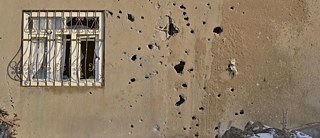Women Writers and War
Close to the horror

War is no longer the exclusive domain of male authors – three books by German-speaking women writers about guilt, repression and omnipresent fear.
Love and war are the ‘spice’ of literature. Direct experience of war, however, was usually the prerogative of male authors, while women wrote, if at all, from the perspective of the hinterland. It was left to them to capture the misery and suffering caused by war or to praise women’s self-sacrifice.
Since the barbarism of the Yugoslav Wars in the 1990s put an end to a long period of peace in Europe, and since the German armed forces have become involved in wars above and beyond the Balkans, the theme has become topical again, even among female authors. In terms of lierature, however, it is not so much about German men who go to Afghanistan or the Congo, leaving civil life behind so as to become immersed in a military collective and survive afterwards as a victim of trauma. Instead these books deal with war reporters and photographers who, since the Iraq War, have been working as so-called embedded journalists. These protagonists point up the paradoxes of war in a reality transposed by misleading images and fake news.
War photographer in a crisis
One of them is the war photographer Bruno Daldossi from South Tyrol, on whom the Austrian writer Sabine Gruber focussed in her 2016 novel Daldossi oder Das Leben des Augenblicks (Daldossi or Living for the Moment). Daldossi has travelled to all the world’s conflict zones; he was in Bosnia and Chechnya, Afghanistan and Iraq, has witnessed the horror and specialized in the “last images”.Back home in Vienna, over the past 15 years his partner Marlis, a zoologist, has awaited his return repeatedly shaken with fear. When he returns for the last time, Daldossi undergoes an existential crisis: dropped by his editor and dependent on alcohol, he simply can no longer cope. Marlis leaves him, saying, “All you have in your head are images,” and, “You have gone too far.” Daldossi argues that you can only take good photographs when you are on the finishing line. His private life is dominated by a distance he has adopted to things and by a memory trained to repress. What is more, he is driven by a feeling of guilt due to the fact that, as an observer-photographer, he was never able to intervene.
Gruber’s tableau presents all the facets of the cynical everyday life of a journalist in war time, supported by authentic and invented commentaries on war photographs. The thrust of her narrative is fed by autobiographical sources; she even took part in a UN training camp for war journalists as part of her research for the novel.
The Training Camp as a Parallel World
The protagonist of Isabelle Lehn’s novel Binde zwei Vögel zusammen (Tie two birds together), also published in 2016, goes to such a training camp for soldiers to be deployed in Afghanistan. Albert, a none too successful journalist, takes a job as an extra, and in the role of Aladdin runs a café and waits for orders. He and the other extras play ‘village life’, and like the undead, let themselves be captured or shot by the soldiers practicing for war: as for dying, Aladdin meantime knows that “The first thing you see is always light.”‘Deployment’ of this kind lasts six weeks, but that is enough to alienate Albert completely from himself. Back in familiar surroundings at his girlfriend’s place, he no longer knows who he is. He drags “the kilos Aladdin put on” around with him, along with the experiences and images he cannot share with anyone. What was initially considered to be a research undertaking becomes a dramatic case of emergency.
Even though, compositionally, this short but incredible story becomes derailed and frazzled here and there, the author provides a subtle impression of an existence oscillating between simulation and reality. “I don’t trust pictures any more since I posed for them myself,” says Albert. Yet the fictional village has become real life for him and he would like to return to it.
Threat is everywhere
What about us civilians who think we were living in quiet zones of peace and who have gathered an inexhaustible supply of idylls on our exotic travels? In her book Wunderbare Jahre. Als wir noch die Welt bereisten (2016, Wonderful Years. When we still travelled the world) Sybille Berg, who lives in Zurich and Tel Aviv, does away with the idea that there is an “elsewhere”, a happy nirvana in which misery can be kept at bay and we can move around without risk or fear.Be it crisis-torn Greece, Paris threatened with terrorist attacks or over-populated India – no matter where Berg travels, threat is already there. Even in the parallel worlds of Bayreuth or Wallis, no one is safe anymore, and, like the insect in Kafka’s story The Metamorphosis, lies in wait at the gable window for the catastrophes brought on by climate change. The image of this insect, and all the other wonderful drawings by Isabel Kreitz accompanying Berg’s travelogue, reconcile us with the author’s occasionally cynical undertone and show once again that the best trip of all is still literature.